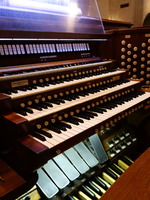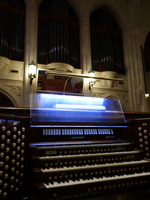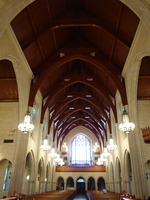I have just finished recording two Widor Symphonies – 6th and Romane – on the Aeolian-Skinner at St. Mark’s Cathedral in Shreveport. The finished product will be out in a few months. But for now, its tale so far is a joyous one.
After hearing Michael Kleinschmidt perform the Romane at St. Mark’s for the 2014 East Texas Pipe Organ Festival, I said to myself, “That is the perfect piece for this organ!” And then I said to myself, “You know, I play that piece pretty well myself. I should record it sometime.” And then I thought, “This organ is a masterpiece – Roy Perry’s largest; it resides in a sumptuous acoustic, is used lovingly and constantly for dignified liturgy, and it has been carefully maintained for its entire life (sixty years in 2015, by my reckoning). Why has it not been recorded professionally?”
And here we are now!
I contacted dear Houston friend Keith Weber about producing this recording. His enthusiasm was contagious, and his professionalism throughout the entire process is most calming. He contacted trusted engineers Ryan Edwards and Shannon Smith of Houston, and we set dates. I was to arrive in Shreveport on Sunday, June 7, 2015, register, and be ready to record Monday-Wednesday, June 8-10.
Being a traveling geek, I added a quick pre-Shreveport stop to this trip. It was only 70 extra miles to Texarkana to visit the grave of my teacher Clyde Holloway, and so I left home a day early to overnight in Texarkana on Saturday and then drive down to Shreveport on Sunday to begin practicing after church.
Sunday, I introduced myself to Bryan Mitnaul, Canon for Cathedral Music, whereupon I discovered that I was about to be treated as a very welcome guest. Bryan was a most gracious and enthusiastic host, and he saw to it that we were never disturbed. That attention to detail is worth the price of admission every time! Many thanks to Bryan.
So I started practicing Sunday afternoon. After about an hour, the Very Reverend Alston Johnson, Dean of the Cathedral, passed through. He saw that I was a stranger in the house, and he offered a warm welcome. Once he discovered why I was there, he knew immediately that it was a special thing, and he expressed a delightful enthusiasm. It is a happy thing when the boss understands and supports what we musicians are up to! Many thanks to Dean Johnson.
Keith and the guys showed up later on Sunday to make friends with the room. Setup began Monday morning, and we were off! From there, I can only stare in wonder at how smoothly everything went. Keith’s approach is refreshingly laid back, allowing plenty of opportunity for me to take brain rests along the way and enjoy leisurely meal breaks. Ryan and Shannon are awfully young, by my standards, but that didn’t affect their top-notch professionalism and deep knowledge base. I am impressed, and Keith swears by them.
Between the Romane and the Sixth Symphonies, there are nine movements – five fast and four slow. We had three days to work with. How to split the movements up? Begin with a slow movement to “warm up” to the recording mindset, or begin with a fast one while energy is fresh? And if starting with a fast movement, should it be a difficult one to get it out of the way, or an easier one for “warmup?” How would the energy hold up best across the three days? Keith suggested that making our way straight through a given Symphony would keep its mood intact throughout all its movements. I have the Sixth memorized, and with due respect to Widor, I’d say its musical challenges are not as acute as the Romane. So off we went with the Romane, while energy was fresh. We recorded its four movements in order. Keith’s approach had me play each movement through at least twice, then record short patches as needed. With his kind care with me and his quick work with the engineers, we got the entire Romane done on that first day! Based on Day One’s success, we began Day Two with confidence. I had to stop for a few more brain rests at Keith’s direction, but we got the entire Sixth done that day. We all left Shreveport a full day early!
Along the way, Keith developed a wonderful salutation for each take. On his way from the console back to the recording table, he would stop and ring the Sanctus bells next to the door and invoke the name of some saint or another. "This is to Saint Bernard!" "This is to Saint Cecilia!" Perhaps the best one of all was on the very last take of the project, which was a long patch for the fourth movement of the Sixth, where he said, "This is to Saint Francis. As in Poulenc! [made smoke puff sound]." It was just the smoky atmosphere I needed to get that perfect, laid-back, screw-you French sound!
Widor’s style only occasionally requires unique colors in the registration. I say that to remind the savvy listener that although the St. Mark’s organ is full of beautiful stops, don’t expect a recording that demonstrates them in great detail. Widor paints his loud movements with large swaths of stops. On the other hand, I have made use of as many colors as I can in the slow movements. For example, where he calls for the Hautbois in the third movement of the Romane, I use the Clarinet from the Choir. Where he calls for it again in the fourth movement of the Sixth, I use the 4-foot Oboe down an octave, rather than the 8-foot Hautbois (yes, they both exist on the Swell). And the strings in the second movement of the Sixth are downright delicious.
It was overwhelming to record this historic music on an historic instrument such as this. It is not exaggerating to say that my mind was constantly flitting back and forth from historical figure to historical figure. From Roy Perry’s landmark ears represented in the voicing, to the history of Bill Teague’s musical leadership on this organ for its first few decades, to G. Donald Harrison’s leadership of Aeolian-Skinner, to my teachers, to Widor himself, I felt audaciously seated among greatness. But what a thrill to bask in the sound of that organ in that room! This is a monumental organ, and I am delighted to have been allowed to record on it. Two Widor masterpieces played on a Roy Perry masterpiece in an acoustical masterpiece of a room. It just doesn’t get any better.


